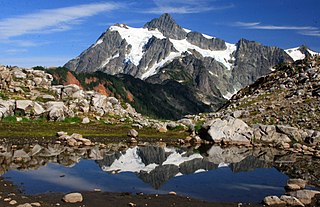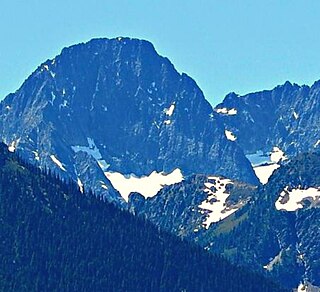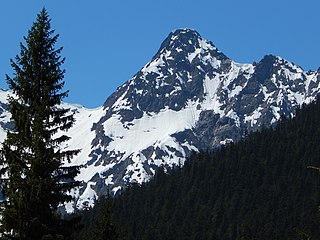
Glacier Peak or Dakobed is the most isolated of the five major stratovolcanoes of the Cascade Volcanic Arc in the U.S state of Washington. Located in the Glacier Peak Wilderness in Mount Baker–Snoqualmie National Forest, the volcano is visible from the west in Seattle, and from the north in the higher areas of eastern suburbs of Vancouver such as Coquitlam, New Westminster and Port Coquitlam. The volcano is the fourth tallest peak in Washington state, and not as much is known about it compared to other volcanoes in the area. Local Native Americans have recognized Glacier Peak and other Washington volcanoes in their histories and stories. When American explorers reached the region, they learned basic information about surrounding landforms, but did not initially understand that Glacier Peak was a volcano. Positioned in Snohomish County, the volcano is only 70 miles (110 km) northeast of downtown Seattle. From locations in northern Seattle and northward, Glacier Peak is closer than the more famous Mount Rainier (Tahoma), but as Glacier Peak is set farther into the Cascades and almost 4,000 feet (1,200 m) shorter, it is much less noticeable than Mount Rainier.

The North Cascades are a section of the Cascade Range of western North America. They span the border between the Canadian province of British Columbia and the U.S. state of Washington and are officially named in the U.S. and Canada as the Cascade Mountains. The portion in Canada is known to Americans as the Canadian Cascades, a designation that also includes the mountains above the east bank of the Fraser Canyon as far north as the town of Lytton, at the confluence of the Thompson and Fraser Rivers.

South Cascade Glacier is a large alpine glacier in the North Cascades of Washington, USA. It is bordered on the east by 8,261-foot (2,518 m) Sentinel Peak, and is about 17 mi (27 km) north of Glacier Peak in the Glacier Peak Wilderness. Meltwater from the glacier flows directly into South Cascade Lake, which feeds the South Fork Cascade River, which is a tributary of the Skagit River.

McAllister Glacier is in a large cirque to the north and east of Dorado Needle, North Cascades National Park, in the U.S. state of Washington. The glacier is approximately 1.85 mi (2.98 km) in length, 1.5 mi (2.4 km) in width at its terminus and descends from 8,000 to 4,500 ft, where it terminates near a proglacial lake. McAllister Glacier is nearly connected to Inspiration Glacier to the south and the two glaciers are separated by the arête known as Tepeh Towers. Klawatti Peak and an arete extending north from that peak separate McAllister Glacier from the Klawatti Glacier to the east. Like most glaciers in the North Cascades, McAllister Glacier is retreating and retreated approximately 1350 ft between 1975 and 2009.

Neve Glacier is in North Cascades National Park in the U.S. state of Washington and is on the north slopes of Snowfield Peak. Neve Glacier flows generally north and splits in two with two terminal tongues, one flowing to the northwest which is known as Ladder Creek Glacier and the other descending a total of more than 1.8 mi (2.9 km) to the east. Ladder Creek Glacier descends from 7,800 to 6,000 ft, while the east tongue also originates from the same altitude and descends to 5,600 ft (1,700 m). Between 1850 and 2006, Neve Glacier is estimated to have retreated more than 1,000 m (3,300 ft).
Diobsud Creek Glacier is in North Cascades National Park in the U.S. state of Washington and is on the east slopes of Bacon Peak. Diobsud Creek Glacier has a shallow gradient, descending to the east from 7,000 to 6,000 ft for a distance of nearly 1 mi (1.6 km). The ridge is an arête which separates Diobsud Creek Glacier from Green Lake Glacier to the north.
Green Lake Glacier is in North Cascades National Park in the U.S. state of Washington and is immediately northeast of Bacon Peak. Green Lake Glacier descends from a ridge extending from the east of Bacon Peak. The glacier forms two tongues descending to the north of the ridge from 6,600 to 5,500 ft. The ridge is an arête which separates Green Lake Glacier from Diobsud Creek Glacier to the south. Meltwater from the glacier spills over Bacon Lake Falls en route to Green Lake.

Company Glacier is in Wenatchee National Forest in the U.S. state of Washington, on the north slopes of Bonanza Peak, the tallest non-volcanic peak in the Cascade Range. Company Glacier descends from 9,200 to 6,500 ft with several main chutes converging into the main glacier below the 7,800-foot (2,400 m) level. Company Glacier was used as the approach route when Bonanza Peak was first climbed in 1937.

Mary Green Glacier is in Wenatchee National Forest in the U.S. state of Washington, on the east slopes of Bonanza Peak, the tallest non-volcanic peak in the Cascade Range. Mary Green Glacier descends from 8,500 to 7,200 ft. Mary Green Glacier was named after the wife of a prospector and lies along the most popular route to the summit of Bonanza Peak.

Nooksack Tower is in North Cascades National Park in the U.S. state of Washington. Nooksack Tower is part of the Mount Shuksan Massif and is .75 mi (1.21 km) northeast of the main summit of Shuksan. Nooksack Tower looms to the west over Nooksack Cirque. The East Nooksack Glacier lies to the southeast, West Nooksack Glacier to the east and Price Glacier is on the north flanks of the tower. Nooksack Tower is one of the most difficult mountains to climb in the Cascade Range, with loose rock, 50-degree or greater slopes and ice ridges as well as accessibility issues and exposure, all weighing into the climbing equation. The descent may require ten or more rappels.
Wyeth Glacier is in North Cascades National Park in the U.S. state of Washington, in a cirque to the west and north of Storm King, a peak 1 mi (1.6 km) northwest of Goode Mountain. Wyeth Glacier is broken into several sections descending from 8,000 to 6,600 ft.
Kimtah Glacier is in North Cascades National Park in the U.S. state of Washington, in a cirque to the west of Kimtah Peak and east of Cosho Peak. Both Kimtah and Cosho Peaks are prominent summits along a ridge known as Jagged Edge. Kimtah Glacier is just under 1 mi (1.6 km) in width and descends northward from 8,100 to 7,000 ft and has four lobes.
Mesahchie Glacier is in North Cascades National Park in the U.S. state of Washington, in a cirque to the northeast of Mesahchie Peak. Mesahchie Peak is the highest summit along a ridge known as Jagged Edge. Mesahchie Glacier is approximately .75 mi (1.21 km) in width and is immediately east of Katsuk Glacier.

Whatcom Peak is in North Cascades National Park in the U.S. state of Washington. Whatcom Peak is .50 mi (0.80 km) north of Challenger Glacier and the Whatcom Glacier descends from the northeast slopes of the peak. An unnamed hanging glacier descends along the northwest flank of the peak. This mountain is set between Mount Challenger and Easy Peak.

Cosho Peak is in North Cascades National Park in the U.S. state of Washington. Cosho Peak is a summit along a ridge known as Ragged Ridge and the Kimtah Glacier is on the northeast slopes of the peak.

Mesahchie Peak is in North Cascades National Park in the U.S. state of Washington. Mesahchie Peak is named after the Chinook word for wicked. Mesahchie Peak is the highest summit along a ridge known as Ragged Ridge and is only .25 mi (0.40 km) east of Katsuk Peak. Both the Katsuk and Mesahchie Glaciers descended down the northwest and northeast flanks of the peak respectively.
S Glacier is in North Cascades National Park in the U.S. state of Washington, on the east slopes of Hurry-up Peak. S Glacier is disconnected in several spots. The uppermost sections terminate in icefalls, while the lower section ends in talus. Total descent of the glacier is from 7,600 to 5,500 ft. Yawning Glacier lies .75 mi (1.21 km) to the north.

Cache Col Glacier is in North Cascades National Park in the U.S. state of Washington, on the east slope of Mix-up Peak. Cache Col Glacier retreated nearly 100 m (330 ft) between 1950 and 2005. Cache Col Glacier is 1 mi (1.6 km) northwest of Yawning Glacier.

Graybeard Peak is a 7,965-foot (2,428-metre) mountain summit located in Skagit County, Washington.

Kitling Peak is an 8,003-foot (2,439-metre) mountain summit in the North Cascades in the U.S. state of Washington. It is located one mile northwest of Easy Pass on the borders of the Stephen Mather Wilderness and North Cascades National Park. Kitling Peak is situated at the east end of Ragged Ridge. Other peaks on Ragged Ridge include Mesahchie Peak, Kimtah Peak, Katsuk Peak, and Graybeard Peak. The nearest higher peak is Mesahchie Peak, 0.95 miles (1.53 km) to the south. The Mesahchie Glacier on Kitling's northwest slope forms the headwaters of Panther Creek. Precipitation runoff on the east side of the mountain drains into Ross Lake via Granite Creek, whereas the west side of the peak drains into Diablo Lake via Panther Creek and Fisher Creek. Topographic relief is significant as the summit rises 3,000 feet above Fisher Creek in one mile (1.6 km) and the northeast slope rises 3,400 feet above Kitling Creek in 0.75 mile (1.2 km). The mountain's name "Kitling" derives from Chinook Jargon "ketling" which means kettle. The mountain takes its name from Kitling Lake which is one mile north of the peak. The toponym was officially adopted in 1969 by the U.S. Board on Geographic Names.














